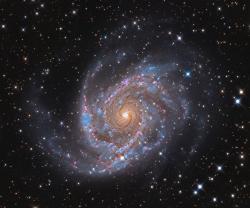
Howdy, Stranger!
It looks like you're new here. If you want to get involved, click one of these buttons!
BlockHead
About
- Username
- BlockHead
- Joined
- Visits
- 257
- Last Active
- Roles
- Member, Administrator
Comments
-
Well... the point of the M42 tutorial was not to be a complete session..but to learn how to manage the detail and color in bright objects (especially with HDRMT). The pixel math you were trying to do is not the same as what LRGB combination does. So…
-
Well... this isn't the typical usage of the screen blending mode.Note that you are trying to combine a greyscale luminance with a color image. This is not the usage I suspect you want. BUT... if you REALLY do want this.. you need to convert your Lum…
-
This is just due to the screening method. There are other more nuanced ways of blending the stars to avoid this. You could, for example, subtract the stars from the NB image before you blend with screen. This is a pretty cool technique...I should do…
-
1. Yes.2. No... that isn't the use case. When BXT does its thing, it looks at the relationships between the channels and operates on them somewhat independently. If you use the Luminance option, it operates on a single image- the luminance component…
-
There is something more going on... Can you post screen shots of your PixelMath screen..and make certain you do not have anything in the "Symbols" tab?? (this is the likely culprit) -the Blockhead
-
Excellent!(that is the point!)-the Blockhead
-
Did you see the last section? (The Bonus?) https://www.adamblockstudios.com/articles/fasttrack-2022-asteroid-bonus -the Blockhead
-
Resample perhaps applies to undersampled data (like crazy undersampled). There isn't a fixed order of operations. There are rules for each process. So you know you cannot resample before SPCC (will mess up the photometry maybe). Resample you would o…
-
Yeah..I never did. This was just a video to help a member... so I didn't go through LRGB combination... I guess I should have. That is an extra complication adding more time. Hmmm... Perhaps I will add an addendum where I blend the LUM and RGB image…
-
I don't think a synthetic luminance is necessary now that BXT is here. Indeed, there is even a luminance mode of BXT. -the Blockhead
-
Where is the image that shows the problem?-the Blockhead
-
Hmm... Well..I don't actually have an HDRCOmposition tutorial... is your data worthy of being an exemplar?-the Blockhead
-
Before I give you an answer... you might want to refine your thinking.Note your list of files... You blinking three different nights in sequential triads. So the thing you see "blinking" is likely only appearing on one night..and not the others...ri…
-
Yeah.. you just multiply 0.196 x2 (basically 0.4). You either keep the focal length the same and adjust the plate scale (by the ratio of the pixel dimensions from 1x1 to 2x2) or you keep the pixel size the same and adjust the focal length to yield …
-
Before I attempt to assist with HDRComposition... of course I am going to point you to what I consider the better method. I say forget about HDRComposition. It relies on a quality linear fitting. I think HDRMT is the way to go. Are you saying in 30 …
-
I believe PixInsight support this..but I do not have experience with it. I know there was an issue with the focus sensor pixels (or something) as well as a central square pattern.You need to research the official forum or make a query there. https:…
-
Yeah..I think so. But... you are now in the deeper end of the pool where I start to make mistakes... so if you can think of a reason why I would need to maintain the reference... let me know.-the Blockhead
-
No.. I do not think you need to set our special frame for the integration of the images. The normalization information is encoded in the Local Normalization files (XNML) which thereby specifies our reference that we used when we generated these file…
-
Hi Alan, Does autocrop really need an update video? (the uncropped version is still available)It just does to the math to return the image that is the intersection of the others after registration and integration. I was considering this minor and wa…
-
Yes...I think you are on the right track now...-the Blockhead
